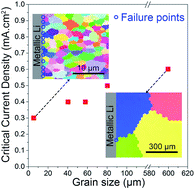Controlling and correlating the effect of grain size with the mechanical and electrochemical properties of Li7La3Zr2O12 solid-state electrolyte†
Abstract
Li7La3Zr2O12 (LLZO) solid-state electrolyte is garnering interest due to its potential to enable solid-state batteries (SSBs) using metallic Li anodes. However, Li metal propagates along LLZO grain boundaries at high Li plating current densities (above the critical current density, CCD). In the present study, we examined whether microstructural aspects, such as grain size, could influence mechanical and electrochemical properties thereby affecting the CCD. A unique densification technique (heating between 1100 and 1300 °C) was used to control grain size. Electron backscatter diffraction determined that the grain size and the misorientation angle varied from 5 to 600 μm and 20 to 40°, respectively. Vickers indentation was used to characterize the mechanical properties and revealed that hardness decreased (9.9–6.8 GPa) with increasing grain size, but the fracture toughness was invariant (0.6 MPa m−1/2) at grain sizes ≥40 μm. DC and AC techniques were used to measure and correlate the CCD with grain size and showed that the CCD increased with increasing grain size achieving a maximum of 0.6 mA cm−2. We believe the implications of this work could be far-reaching in that they represent a significant step towards understanding the mechanism(s) that control the stability of the Li–LLZO interface and a rational approach to increase the CCD in SSBs.



 Please wait while we load your content...
Please wait while we load your content...